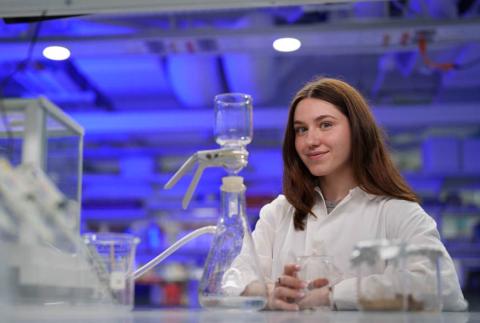
Gabrielle Jarrett ’24 is a marine, estuarine, and freshwater biology major and Classics minor from Exeter, New Hampshire. While an undergraduate, Gabrielle worked in Gregg Moore’s Coastal Restoration and Resiliency Lab and made critical contributions to microplastics research.
Following graduation, Gabrielle will be working as a lab tech in Moore’s lab, processing water and sediment samples for microplastics and formally writing up her work studying patterns of microplastic deposition in salt marshes of the Hampton-Seabrook Estuary, which she plans to submit for publication later in the summer.
She plans to start her master’s degree at UNH in fall 2024 and will continue to study microplastics in coastal wetlands.
COLSA: Tell us about your research in as non-technical language as possible.
Gabrielle Jarrett: My research investigated patterns of microplastic deposition within salt marsh sediment of the Hampton-Seabrook Estuary. Microplastics, defined as plastic particles smaller than 5 millimeters, have been identified as the predominant component of plastic pollution in the marine environment. An estimated 19-23 million tons of plastic enter aquatic ecosystems annually, 80% of which is believed to originate from land-based sources.
Estuaries, positioned at the intersection of terrestrial and aquatic ecosystems, are habitats of critical concern for microplastic pollution. Salt marsh sediment effectively captures microplastics through natural deposition, and sediment cores can be used to track microplastic abundance over time. For this study, paired sediment cores were collected from nine sites within the Hampton-Seabrook Estuary, representing both high and low marsh habitats across upper and lower estuary positions. I then processed cores in the lab via sub-sampling, drying, homogenization, organic material digestion, density separation and vacuum filtration. Resulting microplastics were counted and visually categorized using a dissecting microscope.
COLSA: What challenge/issue does your research seek to address?
Gabrielle: This study aimed to quantify the extent of microplastic pollution and potential spatiotemporal patterns affecting microplastic concentrations within salt marsh sediment of the Hampton-Seabrook Estuary. Specifically, I was looking at how microplastic abundance varies by position in the estuary (upper vs lower estuary), marsh habitat (low vs high marsh) and sediment depth.
COLSA: What have you discovered as a result of your work?
Gabrielle: Microplastics were present in all samples. The majority of microplastics were found in the top 2 cm of sediment, representing approximately 10 years of sediment growth. Microplastic deposition has thus increased within the past 10 years. Significantly more microplastics were found in the upper estuary compared to the lower estuary. Upper estuary sites are further inland with closer proximity to terrestrial pollution sources. Marsh habitat did not significantly influence microplastic abundance.
Overall, microplastic abundance was found to significantly vary by estuary position and sediment depth. This is the first study to investigate microplastics in the salt marsh of the Hampton Seabrook Estuary. Our finding that microplastics decrease with sediment depth is especially cool, because it strongly indicates the increased microplastic deposition in the past decade. This increase in microplastics is likely directly correlated to the exponentially increasing amount of global plastic production and waste.
Additionally, increased coastal flooding as a result of climate change may resuspend and transport microplastic within the estuary, resulting in higher microplastic deposition in the sediment. More research is required to definitively say if there’s a relationship, but it would be great to further investigate this potential relationship between microplastic deposition rates and increasing flooding events as a result of climate change.
COLSA: How has your undergraduate research experience impacted you?
Gabrielle: My undergraduate research experience has been the highlight of my time at UNH. Plastic pollution within the marine environment is a subject that I’m passionate about. I feel lucky to work on a research project that aligns so closely with one of my primary interests as an undergrad.
This hands-on research experience has exposed me to the collaborative nature of science, expanded my technical lab and data analysis skill set, and enabled me to gain confidence in working in a lab setting. My knowledge of microplastic pollution, particularly within coastal wetlands, has increased significantly through this work. The work was personal confirmation that I want to continue working in a lab and pursue a research-based career.
COLSA: Are there funding sources and/or collaborators we should acknowledge? If so, please list.
Gabrielle: This research was supported in part by the Merrimack Valley Planning Commission and NH Sea Grant. I would also like to acknowledge members of the Coastal Habitat and Restoration team for their help and support.
COLSA: What do you love most about UNH?
Gabrielle: I transferred to UNH as a sophomore in the fall of 2022 as a marine, estuarine, and freshwater Biology major. I was drawn to UNH because of its proximity to the coast, programs offered through Shoals Marine Laboratory, and plethora of research opportunities and faculty. As an R1 institution, I knew that UNH would provide excellent opportunities for undergraduate research experience. During my time at UNH I have been able to participate in each of these factors that initially convinced me to attend, namely marine class related field trips to coastal habitats, Shoals course work, and undergraduate research.
I am also grateful for the relationships I have formed at UNH and the community I have built within the lab. The gorgeous campus is another of my favorite things about UNH. I especially love campus in the spring when all the trees are in bloom.